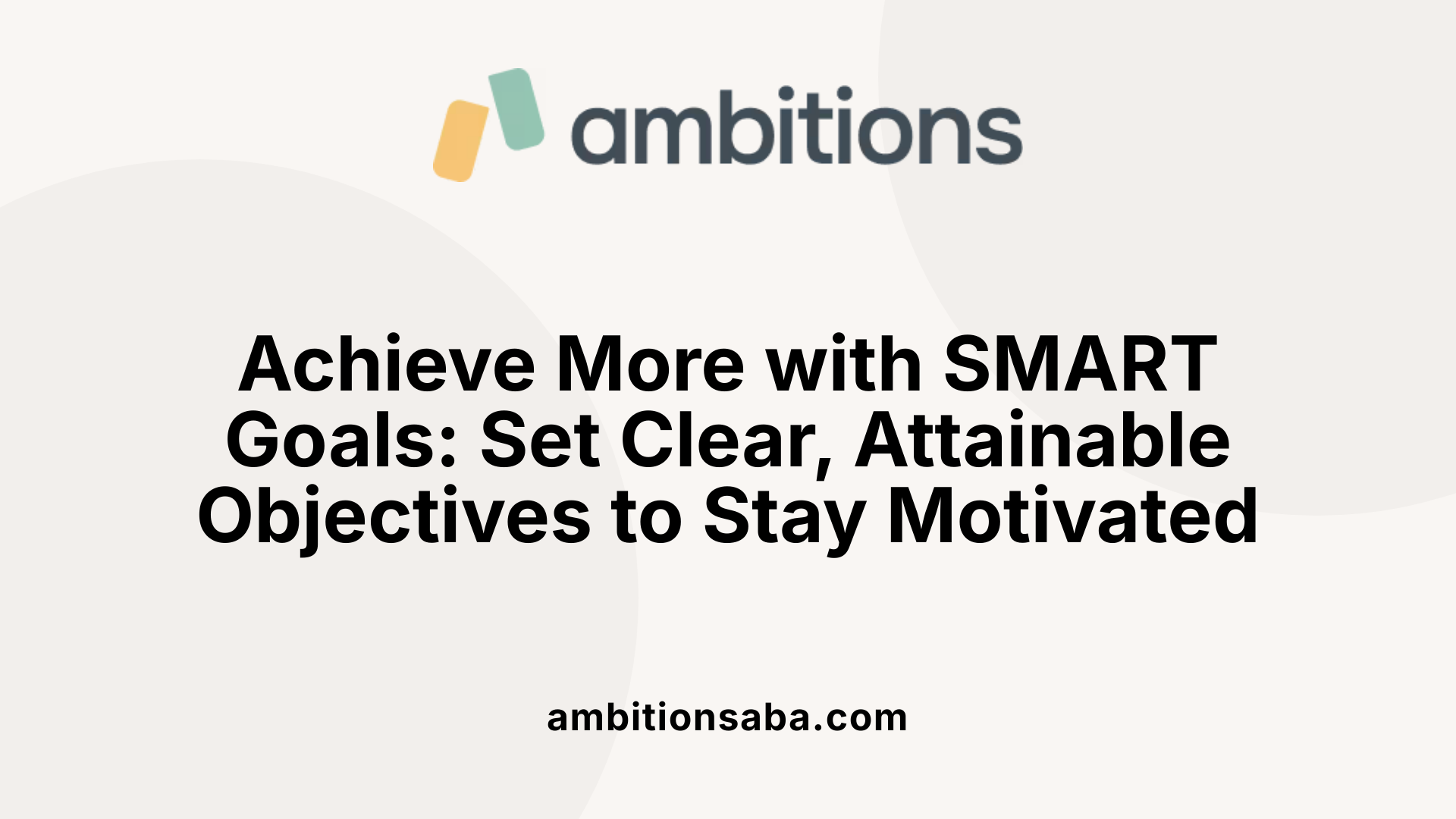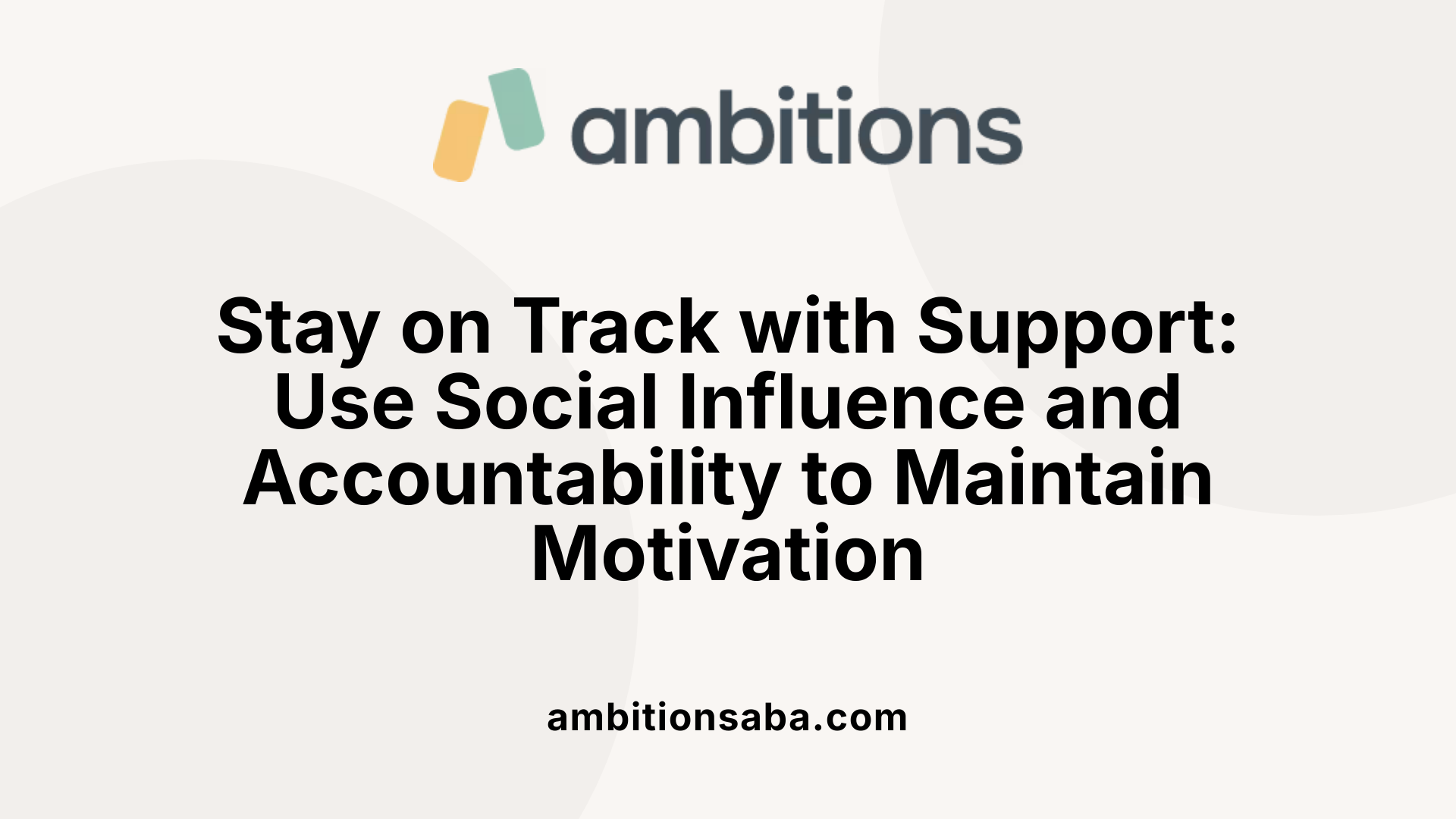Enhancing Intervention Outcomes with Preference Assessments
Understanding Motivation and Its Role in Overcoming Challenges
Motivation is the engine that propels us toward achieving our goals, especially when tasks become difficult or daunting. Building and sustaining motivation requires a combination of psychological insights, strategic planning, and self-awareness. This article explores effective methods to strengthen your motivation for tackling challenging tasks, supported by research and practical tips.
Reconnecting with Your 'Why'

Importance of purpose in motivation
Understanding why a task matters is crucial for maintaining motivation over time. When you recall the deeper meaning or purpose behind your actions, it becomes easier to stay committed, especially during challenging moments. Recognizing the personal significance of your goals—such as supporting your family, pursuing personal growth, or leaving a legacy—can transform a tedious task into a meaningful pursuit.
Having a clear sense of purpose helps to sustain effort and resilience when obstacles arise. It aligns your daily activities with your core values, giving you a compelling reason to persevere even when motivation wanes. Connecting your goals to what truly matters to you fosters intrinsic motivation, which is often more effective for long-term success.
How to identify your core motivations
To harness the power of your 'why,' begin by reflecting on what truly motivates you. Ask yourself questions like:
- What activities make me feel energized?
- When do I feel most fulfilled?
- Which goals align with my personal values?
Writing down your reasons and values can clarify your core motivations. Some common motivators include family, personal achievement, creativity, health, or making a difference in others' lives.
You can also consider visualizing your ideal outcome to reinforce your emotional connection to your goals. This process helps in translating vague ambitions into specific, compelling reasons to act.
Using your 'why' to fuel perseverance
Once you've identified your core motivations, leverage them to overcome setbacks. Remind yourself of your 'why' regularly, especially during tough times. Visual cues like notes, pictures, or reminders on your phone can serve as visual motivators.
Linking your daily efforts to your broader purpose creates a continuous source of inspiration. Whether it’s calling upon your family as a reason to push through a difficult project or recalling your desire for personal growth, your 'why' acts as a powerful catalyst.
In addition, sharing your purpose with trusted friends or mentors can strengthen your resolve. Their encouragement provides external reinforcement, making it easier to stay committed. Ultimately, reconnecting with why you started can reignite your passion and help you persist through challenges.
Harnessing Intrinsic Motivation and Enjoyment

What is the difference between intrinsic and extrinsic motivation?
Intrinsic motivation comes from within, driven by personal satisfaction and enjoyment derived from the task itself. Conversely, extrinsic motivation relies on external rewards, such as money, praise, or penalties. While external incentives can be effective short-term, activities fueled by internal satisfaction tend to foster longer-lasting commitment.
How can creating enjoyable connections to work boost motivation?
Making work more enjoyable can significantly sustain motivation. This might involve pairing tasks with elements you find pleasurable, such as listening to music while studying or incorporating playful activities. When activities relate to things you enjoy, they become less of a chore and more of a rewarding experience.
How do aligning tasks with personal passions increase motivation?
Linking your tasks to your passions or personal values enhances their significance. For instance, a person passionate about helping others may find more motivation in volunteer work or caregiving activities. This alignment triggers intrinsic motivation, making it easier to maintain effort, especially during challenging periods.
What role do specific goals play in boosting motivation?
Setting clear and achievable goals tailored to personal interests can promote intrinsic motivation. Goals that are meaningful and challenge you without being overwhelming encourage continued effort. For example, aiming to learn a new skill related to personal hobbies can motivate sustained practice.
| Strategy | Description | Better Outcomes When Applied | Additional Tips |
|---|---|---|---|
| Connect to passions | Tie tasks to personal interests | Increased engagement and persistence | Reflect on what excites you about the task |
| Incorporate fun elements | Add enjoyable activities | Reduced boredom | Use music, gamification, or social components |
| Set purpose-driven goals | Align goals with core values | Greater commitment | Visualize success linked to personal growth |
Remember, tasks that are intrinsically rewarding are often more sustainable for long-term motivation. Recognizing what personally sparks joy and aligns with your values can transform your approach to work and learning, making efforts feel less like a duty and more like an opportunity for growth.
Setting Clear, Achievable Goals with SMART Criteria

What is the SMART goal framework?
The SMART framework is a popular tool for setting effective goals. It emphasizes that goals should be Specific, Measurable, Achievable, Relevant, and Time-bound.
How do you specify measurable outcomes?
Measurable outcomes are concrete indicators that can track your progress. For example, aiming to bring in 10 new customers or walk 10,000 steps daily provides clear benchmarks that indicate success.
What is the importance of creating intentional timeframes?
Setting a timeframe creates structure and urgency. By establishing clear deadlines, you can better organize your efforts and stay committed to your objectives.
Why are specific and measurable goals important?
Setting specific and measurable goals increases the chances of achievement. It helps clarify what motivates you and reduces ambiguity, making it easier to stay focused. Using the SMART criteria ensures your goals are well-defined, realistic, and timely, which can significantly enhance motivation and progress.
Breaking Down Large Tasks and Celebrating Small Wins

How can subgoaling techniques help with motivation?
Dividing big goals into smaller, manageable subgoals is an effective way to stay motivated. When a task feels overwhelming, breaking it into parts makes it less daunting and easier to tackle. Each small subgoal achieved acts as a stepping stone, providing a sense of accomplishment and encouraging continued effort.
For example, instead of setting a broad goal like 'write a book,' you might set subgoals such as 'write 500 words per day' or 'finish a chapter each week.' These smaller tasks are clearer and more achievable, helping you maintain momentum over time.
How does combating overwhelm boost motivation?
Feeling overwhelmed can lead to paralysis and procrastination. To combat this, focus on the next immediate action rather than the entire project. Use the practice of breaking goals into smaller steps, which reduces anxiety and increases confidence.
Creating a clear plan and setting realistic deadlines can also help. When you know exactly what to do next, overcoming mental hurdles becomes easier, and motivation is sustained as progress is made.
Why is tracking progress helpful?
Using tools like progress bars, checklists, or SMART (Specific, Measurable, Achievable, Relevant, Time-bound) goals provides visual confirmation of your achievements. Seeing tangible evidence of progress boosts motivation by reinforcing the idea that effort leads to results.
Additionally, celebrating small wins along the way can boost your morale. Recognizing each milestone, no matter how small, reinforces positive feelings associated with achievement, encouraging you to keep moving forward.
| Technique | Description | Impact on Motivation |
|---|---|---|
| Subgoaling | Breaking big goals into smaller parts | Reduces overwhelm, builds confidence |
| Combating overwhelm | Focusing on next steps, realistic planning | Decreases fear, enhances clarity |
| Progress tracking | Using visual tools to monitor achievements | Reinforces success, sustains effort |
Focusing on these strategies helps transform daunting tasks into manageable endeavors, making it easier to stay motivated throughout the journey.
The Power of Social Influence and Accountability

How do role models and high performers inspire motivation?
Engaging with individuals who exemplify success or high achievement can significantly elevate your motivation. Observing their habits, attitude, and strategies provides a blueprint for your own actions. High performers often display resilience and dedication that can be contagious. Hearing their stories or learning from their experiences helps foster a positive mindset and encourages you to push through challenges.
What is the role of accountability partners and groups?
Having someone to share your progress and setbacks increases your commitment. Accountability partners or group settings offer external pressure that makes it harder to abandon goals. Regular check-ins and shared updates create a sense of responsibility and can motivate you to stay on track. Additionally, these social connections provide emotional support and encouragement, making the journey less lonely.
How does sharing goals reinforce motivation?
Sharing your aims with others amplifies your intrinsic motivation by creating a social contract with your community or support system. It makes your goals more concrete and public, which can boost your resolve to follow through. Public commitment also evokes positive peer pressure, inspiring you to act consistently with your stated ambitions.
| Method | Impact | Details |
|---|---|---|
| Role Models | Inspiration | Seeing high achievers adopt certain behaviors can motivate imitation. |
| Accountability Partners | Consistency | Regular updates and check-ins help maintain focus. |
| Sharing Goals | Commitment | Publicly declaring aims increases personal responsibility. |
Recognizing the influence of social factors can be a powerful tool in boosting motivation. Whether through observing inspiring role models or fostering accountability via groups, social connections serve as both support systems and motivators. Engaging others with your goals keeps you aligned, accountable, and driven to succeed.
Leveraging Neurotransmitters and Reward Cycles
What is dopamine’s role in motivation?
Dopamine is a key neurotransmitter involved in our brain's reward system. It plays a crucial role in encouraging effort by creating feelings of pleasure when we make progress toward goals. This chemical reward motivates us to repeat behaviors that lead to success.
How can you trigger dopamine through action?
A common misconception is waiting to feel motivated before starting a task. In reality, action often precedes motivation. Engaging in small, manageable steps can stimulate dopamine release, which then boosts motivation. For example, breaking down a large goal into tiny tasks can make the process more approachable.
How does rewarding progress internally and externally enhance motivation?
Rewarding oneself for small wins—whether internally through feelings of pride or externally with treats—can reinforce positive behavior. Internal rewards like feeling accomplished or aligned with personal values tend to lead to more sustained motivation. External rewards, such as praise, work well when balanced properly to support long-term effort.
Research into the neurobiology of motivation shows that dopamine not only motivates us but also maintains the cycle of action and reward. Recognizing this, we can intentionally design activities—like celebrating small achievements—to harness dopamine's power and keep motivation high.
| Aspect | Influence on Motivation | Additional Details |
|---|---|---|
| Dopamine’s function | Enhances effort through positive feelings | Feelings of pleasure reinforce repeated behavior |
| Triggering dopamine | Starting small actions triggers dopamine release | Breaking goals into steps encourages action |
| Internal rewards | Foster ongoing motivation with pride and value alignment | Internal satisfaction sustains long-term effort |
| External rewards | Provide additional motivation when used wisely | Should be balanced to prevent dependency |
Understanding how dopamine influences drive reveals that motivation is not just about desire but also about biological processes. By engaging in small actions and celebrating recent progress, we can stimulate dopamine, thereby creating a positive feedback loop that keeps us moving forward.
Overcoming the Motivation-Feeling Trap
Action before motivation
Many people fall into the trap of waiting until they feel motivated before starting a task. However, research shows that action often precedes motivation. When you begin a small, manageable step, it can create a cycle of effort and reward, triggering your brain’s dopamine system and increasing your drive to continue.
Small steps to trigger motivation
Breaking big goals into small, achievable actions helps you build momentum. For instance, if you need to write a report, start by just opening the document or jotting down an outline. These tiny actions lower the barrier and make starting less daunting.
The 10-minute rule and action cues
The 10-minute rule is a well-known strategy: give yourself permission to work for just 10 minutes. Often, once you start, you find it easier to keep going. Pairing this with specific cues or routines, like setting a timer or listening to motivating music, can strengthen the habit and make it easier to act regardless of how you feel.
Overall, taking immediate action—even if small—can bridge the gap between intention and motivation, helping you stay productive and consistent in your efforts.
The Role of Habits and Routines in Sustaining Motivation
How do automatic behaviors and triggers influence motivation?
Automatic behaviors, also known as habits, are actions that become habitual through repetition in response to specific cues or triggers. These triggers can be environmental, like seeing a gym bag prompting a workout, or temporal, like morning routines. Once established, these habits operate with minimal conscious effort, making it easier to stay motivated over time.
Creating consistent routines helps embed actions into daily life, making them automatic and less dependent on fluctuating motivation levels. For example, set times for work, exercise, or studying can form reliable patterns, reducing decision fatigue and resistance.
How can establishing routines help in building motivation?
Building routines involves designing specific, repeatable actions that align with personal goals. Regularly engaging in these routines skillfully creates a sense of order and progress, which can reinforce intrinsic motivation. For instance, having a morning ritual of planning the day's tasks can set a positive tone.
A predictable routine also provides external structure, making it easier to persist through challenging or less enjoyable tasks. Over time, these routines require less self-control and willpower, conserving energy to tackle more demanding efforts.
How do altering identity and habits contribute to motivation?
Changing how you see yourself—your identity—can significantly impact motivation. For example, adopting the identity of a 'healthy person' or a 'writer' can make habitual effort feel more natural and aligned with self-perception.
When habits are linked to a core aspect of one's identity, they tend to stick longer and feel less like chores. This identity-based approach fosters internal motivation, which is more sustainable than external rewards.
| Concept | Explanation | Impact on Motivation |
|---|---|---|
| Automatic behaviors & triggers | Actions triggered by cues in environment or time | Reduce effort needed to get started, increase consistency |
| Creating routines | Structured, predictable daily actions | Foster discipline and reduce reliance on motivation |
| Identity and habits | Embedding habits into self-perception | Make effort feel aligned with personal values, boosting persistence |
Understanding the formation of habits and their role in motivation can help craft sustainable behaviors that support long-term goals. Developing routines and reshaping identities around desired behaviors turn motivation into an effortless part of daily life.
Environment and External Factors Influencing Motivation
How does distraction elimination boost motivation?
A distraction-free environment is crucial for maintaining focus and motivation. When interruptions are minimized, you can channel your energy more effectively toward your tasks. Clearing clutter, turning off notifications, and creating designated workspaces help reduce mental burden and enable sustained attention.
Why should you consider changing your scenery?
A change of scenery can serve as a quick motivational boost. Moving to a different location, such as a new study spot or workspace, can break the monotony. This shift can refresh your mental state, reduce boredom, and foster a renewed sense of purpose.
How do environmental cues and reminders help?
Regular visual cues and reminders act as external prompts that keep your goals at the forefront of your mind. For example, sticky notes, progress charts, or digital alerts reinforce your commitments and trigger the motivation to act. These signals help maintain momentum, especially during moments when intrinsic motivation wanes.
| Strategy | Benefits | Examples |
|---|---|---|
| Distraction elimination | Improves focus | Decluttering, turning off notifications |
| Change of scenery | Boosts mental stimulation | Moving to a new workspace |
| Environmental cues & reminders | Reinforces goals | Sticky notes, alarms, progress trackers |
Creating a supportive environment with these external strategies can significantly uplift your motivation. By actively managing your surroundings, you set the stage for more consistent effort in your tasks.
Practicing Self-Compassion and Managing Setbacks
Role of self-kindness
Self-compassion plays a vital role in maintaining motivation, especially after setbacks. Instead of criticizing oneself for mistakes or slow progress, practicing kindness fosters a supportive mindset. This gentle approach helps you recover quickly and keeps you engaged with your goals.
Normalizing setbacks and failures
Understanding that setbacks, failures, and difficult moments are natural parts of any journey can reduce frustration and anxiety. Research indicates that accepting these challenges as normal can actually strengthen resilience.
Resilience-building strategies
Building resilience involves developing habits and mindsets that support persistence. Techniques include reframe failures as learning opportunities, celebrate small wins, and maintain focus on long-term goals. Regularly reminding yourself of your "why" and surrounding yourself with supportive individuals can also empower you to bounce back faster.
Self-compassion helps you recover from setbacks without losing motivation. Recognizing that difficulty is normal and viewing failures as growth opportunities fosters resilience and long-term persistence.
Self-Care and Lifestyle Factors for Sustained Drive
How do sleep, nutrition, and hydration impact motivation?
Supportive lifestyle habits, including adequate sleep, nutritious eating, and regular hydration, significantly influence your energy levels and emotional well-being, which are critical for maintaining motivation. When you get enough rest and nourish your body properly, your mental clarity improves, making it easier to stay focused and driven.
What role does physical activity play in boosting mood and motivation?
Engaging in regular exercise releases dopamine, often called the 'feel-good' neurotransmitter. This not only enhances mood but also reinforces the cycle of action and reward, helping you stay motivated to pursue your goals. Even short walks or light stretching can be effective in elevating your energy levels.
How can balancing work and leisure support ongoing motivation?
Balancing work commitments with leisure activities prevents burnout and keeps you energized. Taking breaks, engaging in hobbies, and spending time in nature can rejuvenate your mind, making it easier to return to tasks with renewed enthusiasm. Remember, maintaining this balance nurtures your mental health, which is foundational for sustained motivation.
The Psychological Frameworks and Theories of Motivation
How do Self-Determination Theory and the Goldilocks Rule explain motivation?
Psychological theories such as Self-Determination Theory emphasize the importance of fulfilling three basic psychological needs: competence, autonomy, and relatedness. When these needs are satisfied, individuals are more likely to experience intrinsic motivation—doing tasks because they find them meaningful and satisfying. For example, feeling competent at a task boosts confidence, while feeling autonomous—having control over one's actions—fosters independence. Relatedness, or feeling connected to others, provides additional encouragement and purpose.
The Goldilocks Rule complements this by suggesting that people are most motivated when working on tasks that are neither too difficult nor too easy. Tasks that strike this balance facilitate a flow state—where individuals are fully immersed and lose track of time. This state of optimal challenge keeps motivation high over extended periods.
What role do basic needs like competence, autonomy, and relatedness play?
Meeting the need for competence ensures individuals feel capable and effective, which boosts their willingness to take on challenges. Autonomy allows people to feel in control of their actions, making pursuits personally meaningful and less like chores. Relatedness connects work to a larger purpose or community, reinforcing motivation through social bonds.
How do these theories help sustain long-term motivation?
By designing activities and goals that satisfy these needs, one can foster internal motivation that is more resilient over time. Incorporating challenges that are just right in difficulty encourages flow, keeping engagement steady. Furthermore, connecting tasks to personal values or social goals can deepen the sense of purpose, making motivation less dependent on external rewards. Overall, understanding these psychological principles supports the creation of effective strategies for maintaining motivation.
Harnessing Motivation for Long-term Success
Building motivation for difficult tasks is an ongoing process that combines understanding your deeper purpose, setting achievable goals, creating habits, leveraging social and neurobiological mechanisms, and nurturing self-care. By applying these strategies thoughtfully, you can sustain effort, overcome obstacles, and transform daunting challenges into opportunities for growth and achievement.
References
- Finding Motivation on Important But Non-Urgent Tasks - Zen Habits
- How to Keep Working When You're Just Not Feeling It
- How to Get Motivated and Stay Motivated - Therapy in a Nutshell
- How to Start Tasks & Stay Motivated for Ultimate Productivity
- Motivation - UNC Learning Center
- How to Motivate Yourself to Do Something Difficult - Lifehacker
- How to Motivate Yourself: 11 Tips for Self Improvement - Coursera
- Motivation: The Scientific Guide on How to Get and Stay Motivated

